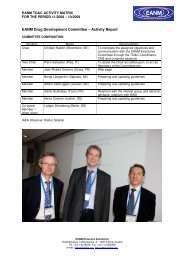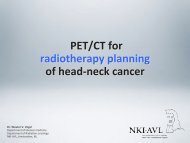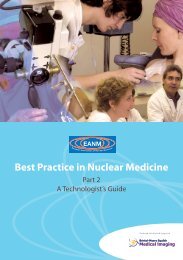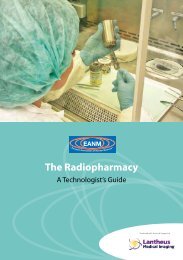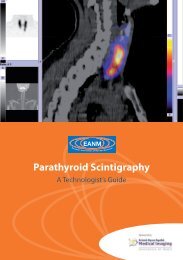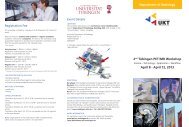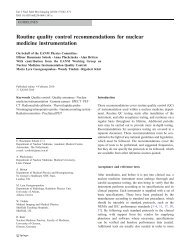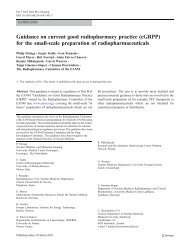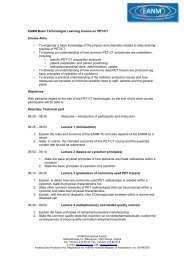EANM Procedure Guidelines for Radiosynovectomy - European ...
EANM Procedure Guidelines for Radiosynovectomy - European ...
EANM Procedure Guidelines for Radiosynovectomy - European ...
You also want an ePaper? Increase the reach of your titles
YUMPU automatically turns print PDFs into web optimized ePapers that Google loves.
<strong>EANM</strong> <strong>Procedure</strong> <strong>Guidelines</strong> <strong>for</strong> <strong>Radiosynovectomy</strong><br />
I. Purpose<br />
The purpose of this guideline is to assist nuclear medicine<br />
practitioners in<br />
1. Evaluating patients who might be candidates <strong>for</strong> intra-articular<br />
treatment using colloidal preparations of<br />
90 Y, 186 Re or 169 Er<br />
2. Providing in<strong>for</strong>mation regarding the per<strong>for</strong>mance of<br />
these treatments.<br />
3. Understanding and evaluating the sequelae of therapy.<br />
II. Background in<strong>for</strong>mation and definitions<br />
A. Definitions<br />
1. Radiation synovectomy/radiosynoviorthesis (RS) in<br />
this context means radionuclide therapy of joint synovitis<br />
or synovial processes by intra-articular injection<br />
of 90Y silicate/citrate or 186Re sulphide or 169Er citrate.<br />
Synovitis means inflammation of the specialised<br />
connective tissue lining of a joint cavity (synovium).<br />
2. i) 90Y emits a beta particle with a maximum energy<br />
of 2.27 MeV, a mean energy of 0.935 MeV and an<br />
average soft tissue range of 3.6 mm. The physical<br />
half-life is 2.7 days.<br />
ii) 186Re emits a beta particle with a maximum energy<br />
of 1.07 MeV, a mean energy of 0.349 MeV,<br />
an average soft tissue range of 1.1 mm and a 9%<br />
abundant gamma emission with a photopeak of<br />
0.137 MeV. The physical half-life is 3.7 days.<br />
iii) 169Er emits a beta particle with a maximum energy<br />
of 0.34 MeV, a mean energy of 0.099 MeV and an<br />
average soft tissue range of 0.3 mm. The physical<br />
half-life is 9.4 days.<br />
B. Background<br />
Intra-articular injection of 90Y silicate/citrate, 186Re sulphide<br />
and 169 Er citrate is approved in Europe <strong>for</strong><br />
the treatment of a range of refractory painful arthropathies.<br />
Physicians responsible <strong>for</strong> treating patients<br />
should have an understanding of the clinical pathophysiology<br />
and natural history of the disease processes,<br />
should be familiar with other <strong>for</strong>ms of therapy and<br />
should be able to liaise closely with other clinicians involved<br />
in managing the patient. The treating clinician<br />
should either see the patient jointly with the rheumatologist<br />
or orthopaedic surgeon assuming overall management<br />
of the patient’s condition or be prepared to<br />
assume that role. The treating clinician should be<br />
appropriately trained and experienced in the safe use<br />
and administration of 90 Y silicate/citrate, 186 Re sulphide<br />
and 169 Er citrate therapy.<br />
Clinicians involved in unsealed source therapy must<br />
be knowledgeable about, and comply with, all applicable<br />
national and local legislation and regulations. The<br />
facility in which treatment is administered must have<br />
appropriate personnel, radiation safety equipment, and<br />
procedures available <strong>for</strong> waste handling and disposal,<br />
handling of contamination, monitoring personnel <strong>for</strong><br />
accidental contamination and controlling contamination<br />
spread.<br />
III. Common indications<br />
90 Y silicate/citrate, 186 Re sulphide and 169 Er citrate are<br />
indicated <strong>for</strong> the treatment of joint pain arising from arthropathies<br />
including:<br />
● Rheumatoid arthritis<br />
● Spondylarthropathy (e.g. reactive or psoriatic arthritis)<br />
● Other inflammatory joint diseases, e.g. Lyme disease,<br />
Behcet’s disease<br />
● Persistent synovial effusion<br />
● Haemophilic arthritis<br />
● Calcium pyrophosphate dihydrate (CPPD) arthritis<br />
● Pigmented villonodular synovitis (PVNS)<br />
● Persistent effusion after joint prosthesis<br />
● Undifferentiated arthritis (where the arthsritis is characterised<br />
by synovitis, synovial thickening or effusion)<br />
Eur J Nucl Med (2003) 30:BP12–BP16<br />
<strong>European</strong> Journal of Nuclear Medicine and Molecular Vol. 30, Imaging No. 3, March Vol. 30, 2003 No. – 1, © January <strong>EANM</strong> 2003
Contraindications<br />
1. Absolute<br />
● Pregnancy<br />
● Breast-feeding<br />
● Local skin infection<br />
● Ruptured popliteal cyst (knee)<br />
2. Relative<br />
● The radiopharmaceuticals should only be used in<br />
children and young patients (
BP14<br />
5. A particle size of at least 5–10 nm is essential to<br />
avoid leakage.<br />
6. Absolute immobilisation of the treated joint(s) <strong>for</strong><br />
48 h using splints or bed rest is recommended as this<br />
will reduce transport of particles through the lymphatics<br />
to the regional lymph nodes.<br />
7. Where possible, simultaneous administration of intraarticular<br />
long-acting glucocorticoids (e.g. methylprednisolone<br />
or triamcinolone) is recommended to reduce<br />
the risk/severity of acute synovitis and to improve<br />
treatment response. [e.g. triamcinolone acetonide<br />
40 mg (1 ml) <strong>for</strong> the knee, hip or shoulder or<br />
20 mg (0.5 ml) <strong>for</strong> elbow, ankle, wrist or subtalar<br />
joints].<br />
8. The needle through which the radiopharmaceutical<br />
has been injected should be flushed be<strong>for</strong>e and during<br />
withdrawal with 0.9% saline.<br />
E. Instructions <strong>for</strong> patients<br />
The importance of joint immobilisation following treatment<br />
should be emphasised. The treating clinician must<br />
advise the patient on reducing unnecessary radiation exposure<br />
to family members and the public. Written instructions<br />
should be provided where required.<br />
Following treatment, patients should avoid pregnancy<br />
<strong>for</strong> at least 4 months.<br />
If in-patient treatment is required, nursing personnel<br />
must be instructed in radiation safety. Any significant<br />
medical conditions should be noted and contingency plans<br />
made in case radiation precautions must be breached <strong>for</strong> a<br />
medical emergency. Concern about radiation exposure<br />
should not interfere with the prompt appropriate medical<br />
treatment of the patient.<br />
F. Precautions<br />
Urinary radiopharmaceutical excretion is of particular<br />
concern during the first 2 days post administration. Patients<br />
should be advised to observe rigorous hygiene in<br />
order to avoid contaminating groups at risk using the<br />
same toilet facility. Patients should be warned to avoid<br />
soiling underclothing or areas around toilet bowls <strong>for</strong><br />
1 week post injection and to wash significantly soiled<br />
clothing separately. A double toilet flush is recommended<br />
after urination. Patients should wash their hands<br />
after urination.<br />
Incontinent patients should be catheterised prior to radiopharmaceutical<br />
administration. The catheter should<br />
remain in place <strong>for</strong> 3–4 days. Catheter bags should be<br />
emptied frequently. Gloves should be worn by staff caring<br />
<strong>for</strong> catheterised patients.<br />
G. Radiopharmaceuticals<br />
1. 90 Y colloids are suitable <strong>for</strong> the knee joint only. The<br />
recommended activity per joint is 185–222 MBq<br />
(5–6 mCi).<br />
2. 186Re sulphur colloid is suitable <strong>for</strong> hip, shoulder, elbow,<br />
wrist, ankle and subtalar joints.<br />
Both the administered activity and the injected volume<br />
of 186Re sulphide colloid vary according to the<br />
volume of the joint to be treated as follows:<br />
Joint Adm. activity Recommended<br />
[MBq (mCi)] volume (ml)<br />
Hip 74–185 (2–5) 3<br />
Shoulder 74–185 (2–5) 3<br />
Elbow 74–111 (2) 1–2<br />
Wrist 37–74 (1–2) 1–1.5<br />
Ankle 74 (2) 1–1.5<br />
Subtalar 37–74 (1–2) 1–1.5<br />
The total activity of 186 Re at a single session should<br />
not exceed 370 MBq (10 mCi).<br />
3. 169Er citrate colloid is suitable <strong>for</strong> metacarpophalangeal,<br />
metatarsophalangeal and digital interphalangeal<br />
joints.<br />
Both the administered activity and the injected volume<br />
of 169Er citrate vary according to the volume of<br />
the joint to be treated as follows:<br />
Joint Adm. activity Recom-<br />
[MBq (mCi)] mended<br />
volume (ml)<br />
Meta-carpophalangeal 20–40 (0.5–1) 1<br />
Meta-tarsophalangeal 30–40 (0.8–1) 1<br />
Proximal interphalangeal 10–20 (0.3–0.5) 0.5<br />
The total 169 Er citrate activity injected at a single session<br />
should not exceed 750 MBq (20 mCi).<br />
4. Doses of radiocolloids delivered to synovium have<br />
been estimated from models of joints using a series<br />
of assumptions. Physicians are referred to: Johnson<br />
and Yanch, Arthritis Rheum 1991; 34:1521–1530;<br />
Bowering and Keeling, Br J Radiol 1978;<br />
51:836–837; Husák et al. Phys Med Biol 1973;<br />
18:848–54; Johnson et al. Eur J Nucl Med 1995;<br />
22:977–988.<br />
5. Extra-articular (unwanted) radiation exposure and<br />
consequent doses have been estimated as follows:<br />
<strong>European</strong> Journal of Nuclear Medicine and Molecular Imaging Vol. 30, No. 1, January 2003
Radio- Numbers Joints/ Post- Organ % injected Estimated<br />
pharma- of patients/ injected injection imaged activity organ abceutical<br />
diagnoses activity management detected sorbed dose<br />
(reference) in organ<br />
90 Y colloids 27/“persistent Knees/ Bed rest <strong>for</strong> Local Mean No<br />
(Gumpel et al., synovitis” 185 MBq 3 days. Some lymph 3.9–5.5% estimate<br />
Br J Radiol 1975; wore a light splint nodes <strong>for</strong> different<br />
48:377–381) colloids<br />
90 Y citrate colloid Not specified/ 6 knee Removable Liver, Not Liver=<br />
(Gratz et al., RA but ? joints/ brace applied spleen specified 27±13 cGy<br />
J Rheumatol 1999; some with 185 MBq <strong>for</strong> at least 72 h. and Spleen=<br />
26:1242-1249)* spondyl-arthritis Patients told not kidneys 12±10 cGy<br />
to move the joint. Kidneys=<br />
„If ever possible 67±33 cGy<br />
patients kept Whole body=<br />
in bed“. 16±9 cGy<br />
169 Er colloid As above 7 finger As <strong>for</strong> 90 Y (above) Whole Not Whole body=<br />
(Gratz et al., joints/ body and specified 0.4±0.3 cGy;<br />
J Rheumatol 1999; 37 MBq single nodes=<br />
26:1242–1249) a nodes up to 4.3 Gy<br />
186 Re colloid As above 23 joints As <strong>for</strong> 90 Y (above) Liver, Not Liver=<br />
(Gratz et al., various/ spleen, specified 10±8 cGy;<br />
J Rheumatol 1999; 74– kidneys spleen=<br />
26:1242–1249) a 111 MBq and local 20±23 cGy;<br />
lymph kidneys=<br />
nodes 9±11 cGy;<br />
nodes=<br />
up to 54 Gy<br />
a Significantly greater extra-articular radiation detection in patients within the group who did/could not manage to immobilise joints<br />
after injection<br />
H. <strong>Guidelines</strong> <strong>for</strong> measuring the activity<br />
to be administered<br />
Use a dose calibrator specially configured to quantify<br />
beta emissions. Pre- and post-administration measurements<br />
should be made to establish the exact injected<br />
activity.<br />
I. Side-effects<br />
1. Early: Increased synovitis: temporary<br />
2. Late: Radionecrosis: rare<br />
J. Follow-up<br />
1. Post-therapy imaging should be undertaken, where<br />
possible, to confirm appropriate radiopharmaceutical<br />
distribution within the treated joint space.<br />
2. Patients should be reviewed 6–8 weeks after injection.<br />
Review should include clinical and laboratory<br />
<strong>European</strong> Journal of Nuclear Medicine and Molecular Imaging Vol. 30, No. 1, January 2003<br />
BP15<br />
indices of treatment response, and assessment of<br />
synovial inflammation and possible radionecrosis.<br />
3. In cases where clinical evaluation cannot provide reliable<br />
indication of failure/response and where appropriate<br />
pre-injection MR/ultrasound data are available,<br />
further MR/ultrasound may be of value to document<br />
changes in synovial volume and/or vascularity.<br />
4. Clinical examination and ultrasound should be repeated<br />
at 3–4 months/6 months and 12 months after<br />
treatment.<br />
5. Pain reduction typically occurs 1–3 weeks post injection.<br />
Treatment failure is likely if no response is<br />
detected by 6 weeks post injection.<br />
6. A few patients who have failed to respond to the first<br />
radionuclide injection report pain reduction and improvement<br />
of joint function following re-treatment 6<br />
months later. Two failed injections should not be followed<br />
by subsequent RS treatments.
BP16<br />
V. Issues requiring further clarification<br />
1. Presumed mechanism of action: After intra-articular<br />
administration the radioactive particles are absorbed<br />
by the superficial cells of the synovium. Beta radiation<br />
leads to coagulation necrosis and sloughing of<br />
these cells.<br />
2. Many authors recommend combined corticosteriod<br />
and radionuclide administration to reduce local inflammation<br />
and to prolong the residence time of the<br />
radiopharmaceutical agent in the joint. The efficacy<br />
of combined steroid/radiocolloid therapy should be<br />
compared with steroid alone in sufficiently powered<br />
randomised controlled studies.<br />
VI. Concise bibliography<br />
There are few well-designed trials to evaluate the efficacy<br />
of radiosynovectomy. Only a minority are prospective<br />
and most are not well-defined regarding joint disease,<br />
stage or sample size.<br />
1. Clunie GPR, Ell PJ. A survey of radiation synovectomy in Eu<br />
rope, 1991–1993. Eur J Nucl Med 1995; 22:970–976.<br />
2. Clunie GPR, Lovegrove FT. Radiation synovectomy. In: Ell<br />
PJ, Gambhir SS, eds. Nuclear medicine in clinical diagnosis<br />
and treatment, 3rd edn. Edinburgh: Churchill Livingston,<br />
Chap. 52.<br />
3. Farahati J, Reiners C, Fischer M, et al. Leitlinie für die Radiosynoviorthese.<br />
Nuklearmedizin 1999; 38:244–245.<br />
4. Göbel D, Gratz S, v. Rothkirch T, Becker W. Radiosynoviorthesis<br />
with rhenium-186 in rheumatoid arthritis: a prospective<br />
study of three treatment regimens. Rheumatol Int 1997;<br />
17:105–108.<br />
5. Heuft-Dorenbusch LLJ, de Vet HCW, van der Linden S. Yttrium<br />
radiosynoviortheses in the treatment of knee arthritis in<br />
rheumatoid arthritis: a systemic review. Ann Rheum Dis 2000;<br />
59:583–586.<br />
6. Johnson LS, Yanch JC, Shortkroff S, et al. Beta-particle dosimetry<br />
in radiation synovectomy. Eur J Nucl Med 1995;<br />
22:977–988.<br />
7. Jones G. Yttrium synovectomy: a meta-analysis of the literature.<br />
Aust N Z J Med 1993; 23:272–275.<br />
8. Mödder G. Radiosynoviorthesis: involvement of nuclear medicine<br />
in rheumatology and orthopaedics. Meckenheim: Warlich,<br />
1995.<br />
9. Savaser AN, Hoffmann K-T, Sörensen H, Banzer DH. Die Radiosynoviorthese<br />
im Behandlungsplan chronisch-entzündlicher<br />
Gelenkerkrankungen. Z Rheumatol 1999; 58:71–78.<br />
10. Taylor WJ, Corkill MM, Rajapaske CNA. A retrospective review<br />
of yttrium-90 synovectomy in the treatment of knee arthritis.<br />
Br J Rheumatol 1997; 36:1100–1105.<br />
11. Weber M. Lokale Gelenkbehandlung bei chronischer Polyarthritis<br />
(cP): intraartikuläre Kortikoide und radioaktive Isotope.<br />
Schweiz Rundschau Med (Praxis) 1993; 82:353–358.<br />
VII. Disclaimer<br />
The <strong>European</strong> Association of Nuclear Medicine has written<br />
and approved guidelines to promote the cost effective<br />
use of high quality nuclear medicine therapeutic procedures.<br />
These generic recommendations cannot be rigidly<br />
applied to all patients in all practice settings. The guidelines<br />
should not be deemed inclusive of all proper procedures<br />
or exclusive of other procedures reasonably directed<br />
to obtaining the same results. Advances in medicine occur<br />
at a rapid rate. The date of guidelines should always be<br />
considered in determining their current applicability.<br />
VIII. Description of the guideline development<br />
process<br />
The <strong>EANM</strong> Radionuclide Therapy Committee has been<br />
involved in the process of guideline development <strong>for</strong><br />
undertaking radionuclide therapies since 1995. A multinational<br />
group of therapy experts developed a series of<br />
monographs on the radionuclide therapy agents licensed<br />
<strong>for</strong> use throughout Europe. Subsequently a series of protocols<br />
was published on the Internet <strong>for</strong> use by members<br />
of the <strong>European</strong> Association of Nuclear Medicine. The<br />
monographs and protocols were achieved through a process<br />
of consensus taking note of the evidence available<br />
at the time of writing. The monographs and protocols<br />
have been in the public domain <strong>for</strong> 4 years and comments<br />
have been received from members of the nuclear<br />
medicine community. The guidelines have been developed<br />
using material within the monographs and protocols<br />
and have been <strong>for</strong>matted to harmonise with the Society<br />
of Nuclear Medicine Therapy <strong>Guidelines</strong> <strong>for</strong>mat.<br />
This guideline has been developed in close collaboration<br />
with Dr. G. Clunie and Prof. M. Fischer, who jointly<br />
contributed to the original text and provided an invaluable<br />
source of practical advice on radiosynovectomy.<br />
Last amended: 4th October 2002<br />
<strong>European</strong> Journal of Nuclear Medicine and Molecular Imaging Vol. 30, No. 1, January 2003





